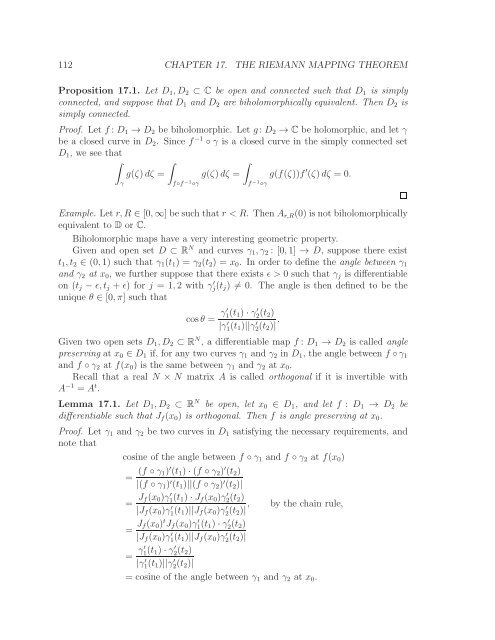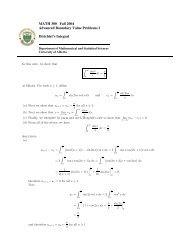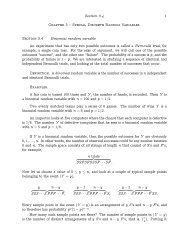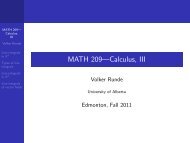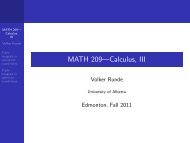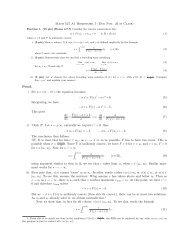Math 411: Honours Complex Variables - University of Alberta
Math 411: Honours Complex Variables - University of Alberta
Math 411: Honours Complex Variables - University of Alberta
Create successful ePaper yourself
Turn your PDF publications into a flip-book with our unique Google optimized e-Paper software.
112 CHAPTER 17. THE RIEMANN MAPPING THEOREM<br />
Proposition 17.1. Let D1,D2 ⊂ C be open and connected such that D1 is simply<br />
connected, and suppose that D1 and D2 are biholomorphically equivalent. Then D2 is<br />
simply connected.<br />
Pro<strong>of</strong>. Let f: D1 → D2 be biholomorphic. Let g: D2 → C be holomorphic, and let γ<br />
be a closed curve in D2. Since f−1 ◦γ is a closed curve in the simply connected set<br />
D1, we see that<br />
� � �<br />
g(ζ)dζ = g(ζ)dζ = g(f(ζ))f ′ (ζ)dζ = 0.<br />
γ<br />
f◦f −1 ◦γ<br />
f −1 ◦γ<br />
Example. Let r,R ∈ [0,∞]besuch that r < R. Then Ar,R(0)isnot biholomorphically<br />
equivalent to D or C.<br />
Biholomorphic maps have a very interesting geometric property.<br />
Given and open set D ⊂ R N and curves γ1,γ2: [0,1] → D, suppose there exist<br />
t1,t2 ∈ (0,1) such that γ1(t1) = γ2(t2) = x0. In order to define the angle between γ1<br />
and γ2 at x0, we further suppose that there exists ǫ > 0 such that γj is differentiable<br />
on (tj − ǫ,tj + ǫ) for j = 1,2 with γ ′ j (tj) �= 0. The angle is then defined to be the<br />
unique θ ∈ [0,π] such that<br />
cosθ = γ′ 1 (t1)·γ ′ 2 (t2)<br />
|γ ′ 1(t1)||γ ′ 2(t2)| .<br />
Given two open sets D1,D2 ⊂ R N , a differentiable map f : D1 → D2 is called angle<br />
preserving at x0 ∈ D1 if, for any two curves γ1 and γ2 in D1, the angle between f ◦γ1<br />
and f ◦γ2 at f(x0) is the same between γ1 and γ2 at x0.<br />
Recall that a real N × N matrix A is called orthogonal if it is invertible with<br />
A −1 = A t .<br />
Lemma 17.1. Let D1,D2 ⊂ R N be open, let x0 ∈ D1, and let f : D1 → D2 be<br />
differentiable such that Jf(x0) is orthogonal. Then f is angle preserving at x0.<br />
Pro<strong>of</strong>. Let γ1 and γ2 be two curves in D1 satisfying the necessary requirements, and<br />
note that<br />
cosine <strong>of</strong> the angle between f ◦γ1 and f ◦γ2 at f(x0)<br />
= (f ◦γ1) ′ (t1)·(f ◦γ2) ′ (t2)<br />
|(f ◦γ1) ′ (t1)||(f ◦γ2) ′ (t2)|<br />
= Jf(x0)γ ′ 1(t1)·Jf(x0)γ ′ 2(t2)<br />
|Jf(x0)γ ′ 1(t1)||Jf(x0)γ ′ 2(t2)| , by the chain rule,<br />
= Jf(x0) t Jf(x0)γ ′ 1(t1)·γ ′ 2(t2)<br />
|Jf(x0)γ ′ 1 (t1)||Jf(x0)γ ′ 2 (t2)|<br />
= γ′ 1 (t1)·γ ′ 2 (t2)<br />
|γ ′ 1(t1)||γ ′ 2(t2)|<br />
= cosine <strong>of</strong> the angle between γ1 and γ2 at x0.


